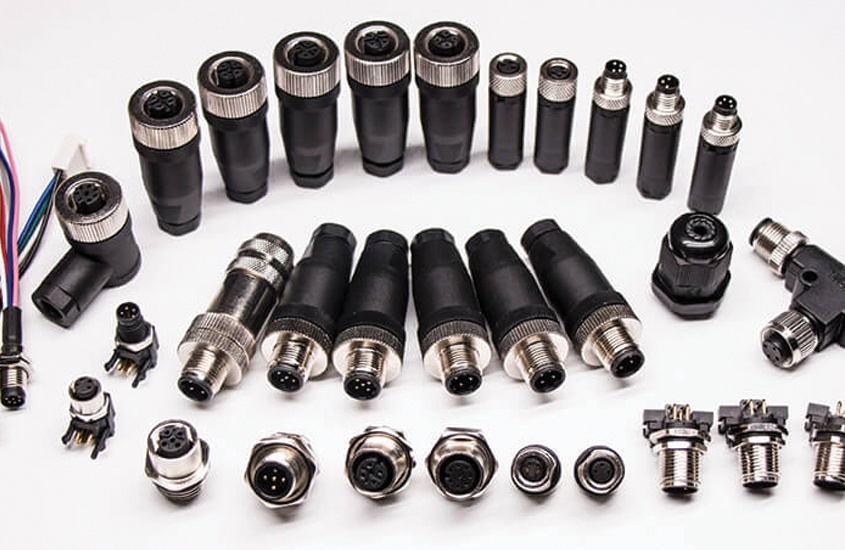M Series Connectors
Are lightweight triplestart ratchet coupling type connectors designed for avionics, aerospace, Harsh Environment Connectors, security, motorsport and heavy duty applications.
The M12 circular connector is designed for washdown and corrosive environments, primarily used in factory automation applications for actuators, sensors, industrial ethernet, and Fieldbus. was first released in 1982 and is a non-standardized 7⁄8-inch three-pin connector used in a few applications. The unique feature of this connector is its connection nut (in most cases)-the housing of the cable end is locked at the cable end in the axial direction, but can rotate freely-so it can be screwed to the socket side On the matching male or female fasteners. First, the connector is standardized by the IEC 61076-2-101 standard for sensors and actuators. In the following years, the standard added a variety of M12 code definitions (detailed descriptions of pin geometry and functional changes), as well as two smaller formats for actuators and PLCs, switches, and I/O Device. These connectors include M8 connectors (defined by IEC 61076-2-104, fastener diameter of 8 mm) and M5 connectors (defined by IEC 61076-2-105, fastener diameter of 5 mm).
The latest version of IEC 61076-2-010 (2020) contains one of the most added contents of the standard in a long period of time-the support and official definition of push-pull connections. Cable companies participating in the standard development include Molex, CONEC, Weidmüller, Phoenix Contact and HARTING. The main advantages of push-pull M12 connectors are:
How to significantly reduce installation time (no need to tighten nuts and verify applied torque)
How to achieve a more compact connection than traditional M12 connectors.
In fact, IEC 61076-2-010 2020 simultaneously defines the geometry of the internal locking subassembly on one half of the female push-pull connector and the external locking subassembly on the half of the male push-pull connector. This will ensure cross compatibility between cable products.

Another connector option
Different from the push-pull M12, there is another circular connector for communication and industrial HMI peripherals-the mini DIN connector. Here, DIN stands for Deutsches Institut für Normung-a standard regulatory organization that regulates the internal structure and connection of these cable terminals. This connector relies on the intervening fit (friction) between the cable end sleeves to keep it inserted into the socket after assembly. This 9.5 mm (3/8 in.) mini DIN connector uses a pin array with 3, 4, 5, 6, 7, 8, or 9 electrical connectors to prevent accidental misconnection of similar-looking mini DIN cables . In many cases, suppliers will add proprietary color codes to the cable ends and machine-side sockets to help assemblers align the two parts of the connection, making installation easier.
Both mini-DIN and mini M12 connectors have their own unique applications. However, there are more non-standard mini-DIN connectors on the market-although the design will be more free, it has also caused confusion. In addition, the interventional fit of the mini-DIN fixed sleeve allows quick connection and disconnection. In contrast, the screw connection of the M12 connector does require more time, but it is inherently safer.
In addition to the number of pins, the code version of the M12 connector has also been standardized. The pin array, channels and grooves (to prevent incorrect mating), and electromagnetic shielding design are specified in detail.
A-coded M12 connectors are everywhere, and they are still used in network sensors and other small devices powered by DC power. B-coded M12 connectors are very common in PROFIBUS devices. The C-coded double key slot (M12 power supply) connector performs well in designs that require AC power for small automation components. The D-coded M12 connector supports 100 Mb/sec Ethernet and PROFINET connections.
The newer M12 code version includes K-code and L-code connectors, which support AC and DC power supply respectively. Similar options include S-coded connectors (which can provide voltages up to 690V for running AC motors), and T-coded M12 connectors for DC power supplies. However, the use of X-coded M12 connectors in supporting 10Gb/s Industrial Ethernet and providing power to actuators such as stepper motors has risen sharply, using the Ethernet 802.3at (PoE+) connection feature for power supply. The latter provides enough power so that various actuators can run at full power.